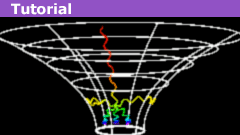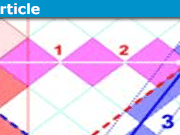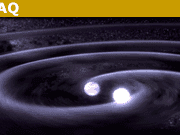The Schwarzschild Geometry: Key Properties
Not long after Einstein published his Field Equation, the first exact solution was found by Karl Schwarzschild. This solution is one of the best known and most often discussed, and its properties have played a significant role in the development of General Relativity as a theory, as well as in efforts to find a theory of quantum gravity. It has also given rise to many misconceptions, and one of my reasons for writing this article series is to provide a good quick reference to help dispel those misconceptions.
In this series of articles, I am going to discuss the key properties of the spacetime geometry described by Schwarzschild’s solution, according to our best current modern understanding. Along the way, I am also going to talk about how that understanding developed and about some of the misconceptions that arose and were later corrected as part of that process of development. I am not going to go into detail about how the solution was derived; if you are interested in that, I give a quick derivation as part of my Insights article about Birkhoff’s Theorem. I am also not going to derive in detail the other equations I give; I encourage you to confirm those equations by deriving them yourself. (In addition to the metric, it will be useful to have the geodesic equation for radial free fall and for circular free-fall orbits; the easiest formulation of that is in terms of an effective potential, as discussed in most GR textbooks.)
To start off, let’s write down the metric of Schwarzschild’s solution, in the most common coordinates used to describe it, which are called Schwarzschild coordinates even though they aren’t quite the ones that Schwarzschild himself used:
$$
ds^2 = – \left( 1 – \frac{2M}{r} \right) dt^2 + \frac{1}{1 – \frac{2M}{r}} dr^2 + r^2 \left( d\theta^2 + \sin^2 \theta d\phi^2 \right)
$$
(I am using units in which ##G = c = 1##.)
GR textbooks rightly stress the fact that coordinates in themselves have no physical meaning; but if we are careful, we can still tell quite a bit about a spacetime by looking at the expression for its metric in a particular set of coordinates, if the coordinates are well chosen. In this case, we can read off some key properties of the Schwarzschild geometry from the above metric:
(1) The metric coefficients are all independent of the coordinate ##t##. That means that the vector field ##\partial / \partial t## is what is called a Killing vector field; along integral curves of this vector field, the local geometry of the spacetime does not change. (It is tempting since ##t## is usually called the “time” coordinate, to say that the geometry “does not change with time”; but we will resist this temptation for now for reasons which will become apparent later on.)
(2) The metric is diagonal. That means, first, that hypersurfaces of constant ##t## are orthogonal to the integral curves of the Killing vector field ##\partial / \partial t##, and second, that within each of these hypersurfaces, the coordinate basis vectors ##\partial / \partial r##, ##\partial / \partial \theta##, and ##\partial / \partial \phi## are all orthogonal. The first property is referred to as the spacetime being “hypersurface orthogonal”–that is, there is a set of hypersurfaces that is everywhere orthogonal to a particular vector field. The second does not have an explicit name that I know of, but is also important, as the next item will show.
(3) The last two terms are just the standard metric on a 2-sphere using standard angular coordinates. That means this spacetime is spherically symmetric–the entire spacetime is an infinite family of 2-spheres, and each 2-sphere is labeled by a unique pair of values for the coordinates ##t## and ##r##. The latter part follows from #2 above, that the tangent vectors on each 2-sphere are orthogonal to the vector fields ##\partial / \partial t## and ##\partial / \partial r##. This is very helpful because it means that for many purposes (including most of what we will discuss here) we can ignore the ##\theta## and ##\phi## coordinates and concentrate on ##t## and ##r## only.
(4) The physical area of a given 2-sphere is ##4 \pi r^2##, where ##r## is the value of the radial coordinate that labels the 2-sphere. This is in fact a way of stating how the coordinate ##r## is defined in this coordinate chart.
Let’s now focus on the constant ##M## that appears in the metric. What does it mean, physically? Of course, we know that ##M## is called the “mass”, but we also know that this solution is a vacuum solution, so there is no matter or energy anywhere; so what is this “mass” the mass of?
We can investigate this by considering an observer who is following a worldline of constant ##r## (and ##\theta## and ##\phi##). We will assume that ##r > 2M##, since it is evident from the metric that this is required for the worldline in question to be timelike (i.e., for the interval ##ds^2## to be less than zero given that ##dt^2## is the only nonzero coordinate differential). What is the proper acceleration of this observer? It is easily computed to be:
$$
a = \frac{M}{r^2 \sqrt{1 – \frac{2M}{r}}}
$$
For ##r >> 2M##, this reduces to ##M / r^2##, which is just the Newtonian proper acceleration of an object that is “hovering” at a constant radius above a gravitating body with mass ##M##. We can confirm the interpretation of ##M## that this suggests by looking at another observer, one who is in a free-fall circular orbit with constant ##r## and ##\theta##; it is easy to show that the coordinate time it takes for such an observer to complete one orbit is:
$$
T = 2 \pi \sqrt{\frac{r^3}{M}}
$$
which should be recognizable as Kepler’s Third Law for an object in a circular Newtonian orbit of radius ##r## around a mass ##M##.
So ##M## appears to have the physical interpretation of “mass”, but this “mass” is a property of the spacetime geometry, not of any “object”–no matter or energy. So now we wonder: what happens to an object that falls radially in this spacetime geometry? If there were an ordinary gravitating body there, like a planet or star, a radially falling object would hit its surface; but there is no ordinary gravitating body there. So what happens?
Let’s first look at the equation for ##dr / dt## for a body that is freely falling radially inward, starting from rest at infinity. This equation is:
$$
\frac{dr}{dt} = – \left( 1 – \frac{2M}{r} \right) \sqrt{\frac{2M}{r}}
$$
For ##r \rightarrow \infty##, this goes to zero, which is consistent with our initial condition of “at rest at infinity”. As ##r## decreases from very large values, ##dr / dt## increases for a while; but then it starts decreasing again, and approaches zero once more as ##r \rightarrow 2M##.
We have just run up against one of the main misconceptions about Schwarzschild spacetime. This behavior of ##dr / dt## seems to tell us that the infalling object slows down as it approaches ##r = 2M##, and never quite reaches that point (it is easily shown that ##r > 2M## for any finite ##t##). Many physicists in the first few decades after the Schwarzschild solution was discovered attributed this apparent behavior to gravitational time dilation. However, the behavior is only apparent. The quantity ##dr / dt## is a coordinate speed; in itself, it has no physical meaning. If we want to extract physical meaning from it, we need to relate it to some invariant–some quantity that doesn’t depend on the coordinates. We did that above when we enumerated our properties #1, #2, #3, and #4; in each case, we found an invariant feature of the geometry (Killing vector fields, orthogonality, etc.) that corresponded to the coordinate property in question. So what is the relevant invariant now?
There is one obvious invariant for the infalling object: the quantity ##dr / d\tau##, the rate of change of ##r## with respect to the infalling object’s own proper time. Note that this is in fact an invariant because ##r##, even though it appears as a coordinate in the chart we are using, has an invariant geometric interpretation in terms of the physical area of 2-spheres (our fourth property above). So ##dr / d\tau## is telling us how fast the areas of 2-spheres the object is falling past decrease, with respect to the object’s own clock.
The equation for ##dr / d\tau## is even simpler; it is just
$$
\frac{dr}{d\tau} = – \sqrt{\frac{2M}{r}}
$$
This does not go to zero as ##r \rightarrow 2M##; instead, it is equal to ##- 1## at that point (the minus sign is because the object is falling inward), and continues to increase in magnitude (i.e., get more negative) as ##r## decreases. So as far as the infalling object is concerned, it keeps on falling right through ##r = 2M## (or equivalently through the 2-sphere with physical area ##16 \pi M^2##) and on to smaller 2-spheres.
What is going on here? We have two seemingly contradictory predictions: the equation for ##dr / dt## is telling us that an infalling object slows down more and more and never quite reaches ##r = 2M##; while the equation for ##dr / d\tau## is telling us that the object continues to speed up as it falls, and goes right through ##r = 2M## and beyond. Which one is right?
We have one other indication that we haven’t talked about yet: the metric in the coordinates we have been using behaves strangely at ##r = 2M##. The coefficient of ##dt^2## goes to zero, and the coefficient of ##dr^2## is undefined. This raises the suspicion that the behavior of ##dr / dt## as ##r \rightarrow 2M## might be an artifact of the coordinates. What we would like to do is find a coordinate transformation that removes at least some of the strange behavior at ##r = 2M##. Fortunately, there is one, first discovered as long ago as 1921-2, but its full implications were not widely recognized until much later. These coordinates are called Gullstrand-Painleve coordinates, after two physicists who independently discovered them.
The idea is to try to rescale the time coordinate so that it reflects the proper time of the radially infalling object. The transformation that does that is:
$$
T = t – 2M \left[ – 2 \sqrt{\frac{r}{2M}} + \ln \left( \frac{\sqrt{\frac{r}{2M}} + 1}{\sqrt{\frac{r}{2M}} – 1} \right) \right]
$$
The metric that results is:
$$
ds^2 = – \left( 1 – \frac{2M}{r} \right) dT^2 + 2 \sqrt{\frac{2M}{r}} dT dr + dr^2 + r^2 \left( d\theta^2 + \sin^2 \theta d\phi^2 \right)
$$
It is easily shown that the coordinate speed ##dr / dT## of an object free-falling radially inward from rest at infinity is now ##- \sqrt{2M/r}##, as we desired–i.e,. that the time coordinate ##T## in this chart now directly reflects the proper time of such infalling objects. So the behavior of ##dr / dt## in Schwarzschild coordinates as ##r \rightarrow 2M## was in fact an artifact of the coordinates and was not telling us anything physical.
To rephrase this last statement: the radially free-falling object does reach and go beyond ##r = 2M##. The behavior of ##dr / dt## in Schwarzschild coordinates is not telling us about the object; it’s telling us about the coordinates–that they become highly distorted as we get close to ##r = 2M##, to the point of “infinite distortion” exactly at ##r = 2M##. Notice that the coordinate transformation that takes us from Schwarzschild coordinates to Gullstrand-Painleve coordinates is itself singular at ##r = 2M##. That is because of the distortion of Schwarzschild coordinates. (In the next article, when we look at still other coordinate charts, we will find a way to actually visualize this distortion.) It is the quantity ##dr / d\tau##, or ##dr / dT## in Gullstrand-Painleve coordinates, that is telling us about the infalling object itself.
But we’re not done; the metric in Gullstrand-Painleve coordinates still has the property that the coefficient of ##dT^2## goes to zero at ##r = 2M##. In other words, the vector field ##\partial / \partial T##, like the vector field ##\partial / \partial t## in Schwarzschild coordinates, is no longer timelike at ##r = 2M##. (In fact, these are the same vector field, just described in different coordinates.) Also, the radial speed ##dr / d\tau## of the infalling object (which is also its coordinate speed ##dr / dT## in Gullstrand-Painleve coordinates) has magnitude ##1## at ##r = 2M##, and still larger magnitude for ##r < 2M##; but magnitude ##1## is the speed of light in the units we are using. Does that mean the infalling object can go as fast as, or faster than, light? If not, what do those magnitudes mean?
So we still have more investigating to do. We’ll continue that in the next article.
- Completed Educational Background: MIT Master’s
- Favorite Area of Science: Relativity








[QUOTE="Nugatory, post: 5694877, member: 382138"]The Schwarzschild radial coordinate is defined (outside the horizon) by ##A=4pi{r}^2##,[/QUOTE]It's also defined that way inside the horizon. And the definition of ##r## works fine even at the horizon, although Schwarzschild coordinates overall are singular there; there are other charts (such as Painleve and Eddington-Finkelstein) which define ##r## the same way and are not singular at the horizon.[QUOTE="Android Neox, post: 5694839, member: 543121"]Einstein was right that event horizons are impossible because they cannot form in finite time.[/QUOTE]Einstein never made such a claim, as far as I know. He made two different claims about the minimum possible radius of a stationary system being larger than ##2M## (the event horizon radius corresponding to mass ##M##); neither one had anything to do with the time required to form a horizon. Both claims were correct mathematically speaking, but his physical interpretation ignored the possibility of non-stationary collapse.
[QUOTE="Android Neox, post: 5694839, member: 543121"]For one thing, the radius is defined from the center of mass out to the surface.[/QUOTE]It is not. The Schwarzschild radial coordinate is defined (outside the horizon) by ##A=4pi{r}^2##, where ##A## is the area of a sphere centered on the origin; that sphere defines a surface of constant ##r##.[QUOTE]event horizons are impossible because they cannot form in finite time.[/QUOTE]This is a very common misconception, usually the result of misinterpreting the Schwarszchild ##t## coordinate and/or forgetting that the Schwarzschild solution is a static solution so does not account for the change of mass of the black hole when something falls into it. If you want more explanation of how this works, you should start a new thread, but not until after you have:1) Worked you way through the Oppenheimer-Snyder solution to the Einstein Field Equations.2) Looked at the worldline of an infalling test particle in Kruskal coordinates, so you aren't misled by the coordinate singularity at the event horizon.3) Looked at some of the many other threads on the subject here.But in any case – this is a new topic, so don't continue the discussion in this thread.
A problem with the Schwarzschild view of black holes is that it depends upon a Euclidean view of space. The radius is defined from the perspective of an observer at infinite distance. This eliminates the spacetime dilation of the gravitational field. For one thing, the radius is defined from the center of mass out to the surface. In Relativity, this region has no definition. The concept "radius" has no sensible interpretation in this case. By taking the view of the observer at infinity, the radius can be defined in terms of a distance to the Schwarzschild radius, but this description is meaningless when viewed "close to" the black hole. I put "close to" in quotes because the distance to any event horizon from any point in space will be infinite. Rather, the rules of Relativity require that this distance is infinite.The Shapiro effect shows that space is dilated in a gravity well. The amount of dilation is proportional to the difference in gravitational potential energy between the observer and the observed. For an event horizon, the difference in gravitational potential energy between the EH and any point in space is infinite.Einstein was right that event horizons are impossible because they cannot form in finite time.
[QUOTE="tomdodd4598, post: 5652997, member: 562804"]How do you go about this – directly from the metric or from the geodesic equations?[/QUOTE]You can use the geodesic equation, yes. You can also use the conserved quantities and the effective potential equation to find expressions for ##dr / dtau##, where ##r## is the "areal radius" (i.e., a 2-sphere at ##r## has area ##4 pi r^2##) and for ##dt / dtau##, and then take their ratio to get ##dr / dt##.
I have read through your four articles and found them really interesting and very well written! When I originally read them, it was just because I was interested, but now I'm going back through the calculations – there's one part where you calculate the coordinate velocity of a radially free-falling body from rest at infinity (it comes out as the same as the proper velocity in Schwarzschild coordinates). How do you go about this – directly from the metric or from the geodesic equations? I tried finding the expressions for the conserved quantities, but the energy came out rather nasty.
[QUOTE="vanhees71, post: 5643385, member: 260864"]QFT in the Schwarzschild spacetime[/QUOTE]I don't plan to talk about that in this series of articles; I'm only talking about the classical Schwarzschild solution.
[QUOTE="vanhees71, post: 5643385, member: 260864"]Will there be a discussion of the complete extensions of the Schwarzschild solution like Kruskal coordinates?[/QUOTE]Yes, coming in further articles in the series.
Will there be a discussion of the complete extensions of the Schwarzschild solution like Kruskal coordinates? I'd really finally like to understand it's meaning. Recently 't Hooft visited our university and gave a talk about QFT in the Schwarzschild spacetime and the problem, what happens to a particle which "goes through a wormhole". The main problem seemed to be to get a proper physical interpretation of the asymptotic states, and he said there's still controversies in the community.
Great insight. When will the second part come in?
[QUOTE="George Jones, post: 5642417, member: 31570"]Everyone else on the Special and General Relativity forum uses the acronym SR to "Special Relativity".[/QUOTE]I'm sorry. I knew that and made a mistake. I will spell everything out from now on.
[QUOTE="PeterDonis, post: 5642410, member: 197831"]Those are fine for the topic of a new thread. (I'm not sure why you would describe them as "variations on SR", though.).[/QUOTE]My guess is that my guess is Hyperstrings has used very non-standard terminology, and this has resulted in miscommunication.Hyperstrings by SR, do you mean "Schwarzschild Relativity"? Everyone else on the Special and General Relativity forum uses the acronym SR to "Special Relativity".
[QUOTE="HyperStrings, post: 5642322, member: 611083"]I mean di sitter-Schwarzchild metrics[/QUOTE]Those are fine for the topic of a new thread. (I'm not sure why you would describe them as "variations on SR", though.)[QUOTE="HyperStrings, post: 5642322, member: 611083"]questions about Schwarzchild relativity.[/QUOTE]If you mean questions about the Schwarschild geometry, if it's something discussed in the article, you can ask it here. Or you can start a new thread. Just bear in mind that answers will be based on that specific model–i.e., that specific solution of the Einstein Field Equation in classical GR.
[QUOTE="PeterDonis, post: 5642311, member: 197831"]by "variations on SR"[/QUOTE] I mean di sitter-Schwarzchild metrics, or questions about Schwarzchild relativity.
[QUOTE="HyperStrings, post: 5642310, member: 611083"]Perhaps we'll go into variations on SR[/QUOTE]Not here on PF, since PF does not allow discussion of speculative or personal theories.
[QUOTE="PeterDonis, post: 5642115, member: 197831"]Can you restate it using math instead of vague ordinary language?[/QUOTE]. Yes, but I am not trying to distract you into tangents during your paper. It is quite good. Perhaps we'll go into variations on SR some time down the road in a different thread?
Great Insight Peter!
[QUOTE="HyperStrings, post: 5641985, member: 611083"]Would that infalling velocity slow down, if we were to magnify the hyper planckian singularity as we move into the center? Just as if we spatially zoom into Earth using relativistic functions, while moving quickly towards Earth, from very, very, faraway, our spatial awareness observes the removal of the drag in velocity in the observation of the schwarzchild singularity as we move towards it.[/QUOTE]I don't understand what any of this means. Can you restate it using math instead of vague ordinary language? (If you can't, you might want to rethink the question.)
[QUOTE="Nugatory, post: 5642026, member: 382138"]If you look at the sign of the metric coefficients, you'll see that ##frac{partial}{partial{r}}## is timelike in that region.[/QUOTE]This is true in Schwarzschild coordinates, but not in Painleve coordinates. In Painleve coordinates, all four of the coordinate basis vectors are spacelike in the region ##r < 2M##! This is an excellent illustration of why you have to be careful basing anything on properties of coordinate charts.I'll leave the question of how we can in fact confirm that there are still timelike vectors in the region ##r < 2M## in a chart like Painleve as an exercise for the reader, at least for now. :wink: There are more posts coming in this series and I might address this issue in one of them.
Thank you, Nugatory and PeterDonis. I actually have been intrigued recently by schwarzchild, de sitter and other subatomic geometries/topologies, so I really appreciate the subject matter.
[QUOTE="HyperStrings, post: 5641985, member: 611083"]"the infalling object slows down as it approaches r=2M" Would that infalling velocity slow down, if we were to magnify the hyper planckian singularity as we move into the center?[/quote]We are approaching ##r=2M## so we're still outside the event horizon. What's going on around the singularity is, by Birkhoff's theorem, completely irrelevant.[quote]"the vector field ∂/∂t in Schwarzschild coordinates, is no longer timelike at r=2M "How do you have any sort of 'dynamics', without time?[/QUOTE]At ##r=2M##, the Schwarzschild coordinates have a coordinate singularity, so they cannot be used to describe the dynamics there. However, that's just an artifact of having chosen that coordinate system (like trying to determine the longitude of the earth's north pole); Painleve or EF or Kruskal coordinates all work just fine for describing the dyamics there.At ##r<2M## the vector field ##frac{partial}{partial{t}}## is not timelike, but that doesn't mean that there's no time: ##frac{partial}{partial{r}}## is timelike in that region.
Nice one, Peter. I learned from Zee's book that independently from Schwarzschild, Johannes Droste also derived the same solution, a few months after Schwarzschild send his solution to Einstein.
"the infalling object slows down as it approaches r=2M" Would that infalling velocity slow down, if we were to magnify the hyper planckian singularity as we move into the center? Just as if we spatially zoom into Earth using relativistic functions, while moving quickly towards Earth, from very, very, faraway, our spatial awareness observes the removal of the drag in velocity in the observation of the schwarzchild singularity as we move towards it. "the vector field ∂/∂t in Schwarzschild coordinates, is no longer timelike at r=2M " How do you have any sort of 'dynamics', without time?